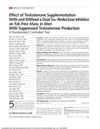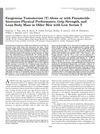TLDR Testosterone boosts red blood cell production and changes iron metabolism without needing dihydrotestosterone.
The study investigated the effects of testosterone-enanthate (TE) on red blood cell production and iron metabolism in 60 older hypogonadal men over 12 months. TE increased red blood cell count, hematocrit, and hemoglobin while significantly reducing serum hepcidin, indicating enhanced iron utilization for erythropoiesis. The use of finasteride, a 5α-reductase inhibitor, did not alter these effects, demonstrating that TE stimulated erythropoiesis and altered iron homeostasis independently of dihydrotestosterone (DHT). The findings suggested that elevated DHT was not necessary for these androgen-mediated effects, supporting the potential of TE in treating anemia in hypogonadal men without requiring DHT conversion.
 124 citations
,
March 2012 in “JAMA”
124 citations
,
March 2012 in “JAMA” Testosterone's muscle-building effects do not require its conversion to DHT.
35 citations
,
October 2011 in “Medicine and science in sports and exercise” Muscles can make their own androgens, which may help muscle growth.
42 citations
,
May 2007 in “Endocrinology and metabolism/American journal of physiology: endocrinology and metabolism” Testosterone can build muscle and bone without enlarging the prostate when a specific enzyme is blocked.
 506 citations
,
March 2005 in “The Journal of Clinical Endocrinology and Metabolism”
506 citations
,
March 2005 in “The Journal of Clinical Endocrinology and Metabolism” Testosterone therapy improves physical function, strength, and body composition in older men with low testosterone levels.
 417 citations
,
February 2004 in “The Journal of Clinical Endocrinology and Metabolism”
417 citations
,
February 2004 in “The Journal of Clinical Endocrinology and Metabolism” Testosterone therapy increases bone density in older men with low testosterone levels.
115 citations
,
March 2001 in “Baillière's best practice and research in clinical endocrinology and metabolism/Baillière's best practice & research. Clinical endocrinology & metabolism” Key enzymes control androgen levels, affecting hormone activity and potential treatments.
 June 2023 in “Clinica Chimica Acta”
June 2023 in “Clinica Chimica Acta” Finasteride and dutasteride effectively reduce DHT in hair, which may help evaluate their treatment success for hair loss.
 65 citations
,
October 1999 in “Journal of The American Academy of Dermatology”
65 citations
,
October 1999 in “Journal of The American Academy of Dermatology” Finasteride effectively reduces hair loss by decreasing androgen levels.
 59 citations
,
September 1994 in “The Journal of Clinical Endocrinology and Metabolism”
59 citations
,
September 1994 in “The Journal of Clinical Endocrinology and Metabolism” Finasteride reduces scalp DHT levels, potentially treating male pattern baldness.






